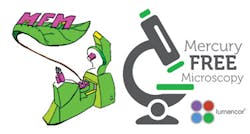FLUORESCENCE MICROSCOPY: A program to help labs 'go green'
Mercury reduction has become a hot topic in biomedical imaging. Mercury is a toxic element, but because of its heretofore-unique capability to emit several color bands that appear bright white to the human eye, mercury-generated light has been a mainstay in biomedical research equipment, particularly in fluorescence microscopy. In fact, the National Institutes of Health (NIH) and many other institutions have generally banned the use of mercury, but exempted mercury-based science-grade lighting because it is "essential."
Suppliers have been working to address the need to reduce or eliminate mercury through product offerings that also offer other benefits. By 2007, CoolLED (Andover, England) was already talking about LED-based sources sufficiently capable for fluorescence microscopy, and in 2008, Lumencor (Beaverton, OR) announced its mercury-free "smart light engine" technology (see "Light engines: Lighting the way to mercury-free microscopy"). Subsequently, 89 North (Burlington, VT) released Heliophor, a mercury-free pumped-phosphor light engine for which the company has won recognition, including the 2011 Vermont Governor's Award for Environmental Excellence. And both Sutter Instrument (Novato, CA) and Lumen Dynamics (Mississauga, ON, Canada) now offer long-life LED sources Lambda TLED and X-Cite 120LED, respectively.
Mercury Free Microscopy
In late 2012, Lumencor's offering of a "true white light mercury replacement" inspired McGill University (Montreal, QC, Canada) physiology professor Claire M. Brown to write a proposal, with input from Lumencor's Regan Baird, to cover replacement of microscope light sources using McGill's Sustainability Projects Fund. Lumencor dubbed this initiative Mercury Free Microscopy (MFM) and decided it was too wonderful not to expand. So Brown's idea has grown to become a program that Lumencor uses to inform institutions about the benefits of high-performance, sustainable, mercury-free lighting, and then to help support the replacement of mercury-based lighting in their labs. This includes identifying stakeholders to help defray the initial costs. Because while Baird reports that mercury-free lighting is cost-efficient after as little as a year, it's also true that retrofitting existing instrumentation represents a barrier to entry. He says that MFM can help to create a financial partnership using laboratories' consumable budgets, funds from institutional stakeholders (such as sustainability and environmental health and safety programs), the buying power of the institution, energy rebate and incentive programs, and potential monies from private donations.
Brown noted that the program is a great way for core facilities to get institutional support and get rid of mercury; in fact, another goal of MFM is to reinforce compliant mercury reclamation. "We are in the process of replacing most of our mercury-based light sources," Brown told BioOptics World. "We are also developing an advertising/awareness campaign that connects institutional stakeholders, such as the purchasing department, with the scientific experts in a mutually beneficial collaboration."
At McGill, MFM is spearheaded by the university's Advanced BioImaging Facility (ABIF), the Cell Imaging and Analysis Network (CIAN), and the Montreal Neurological Institute (MNI) microscopy core. On the basis of their testing, students and staff have compiled information relating to stability on multiple time scales, power consumption, and stability after switching on and off for mercury-free light engines. The study team has presented their results in public informational sessions that include both the scientific research and sustainability communities. According to Brown, "These new light sources surpass mercury-based technology to improve light source stability (within ~1%), reduce power consumption and avoid the use of mercury." She explained that this allows scientists to collect superior scientific image data and saves staff time, noting that the ABIF would typically change and align 2–4 mercury bulbs per month. "In addition, testing these light sources has made for several wonderful undergraduate student projects," she said.At Harvard Medical School's (Boston, MA) Nikon Imaging Center, the promise of improved research data was what inspired the move from metal-halide sources to light engines. According to Center director Jennifer Waters, because their light intensity doesn't degrade over time, light engines provide more stability for collecting data—which is key for time-lapse experiments.
The Center conducted a six-month pilot program to learn whether mercury-free light engines would satisfy researchers' needs. Harvard's Green Building Services conducted a "Life Cycle Analysis," which showed that the savings resulting from infrequent light source replacement were far higher than the expected energy savings. In all, the costs for replacement, operation, and disposal were reduced by half. Based on results of the study, Waters and her team decided to install light engines on the majority of their microscopes. "I hope we will inspire others using microscopy to consider this more efficient fluorescence illumination option not only for the positive sustainability benefit, but also because it leads to better data," she said.
According to Baird, labs often have duplicate microscopy systems that are underused because of lacking accounting and administration. "The instruments, scientists, core directors, institution, and environment all benefit from light engine technology," he explained. The imaging core facility director, the ideal champion for institutional MFM, can use the program to consolidate the institutional instrumentation network, centralize instrument administration, explore alternative funding sources, become involved in green laboratory programs, and be an increasingly recognized institutional resource for equipment grants and experimental design.
Find out more about McGill's project on the university's sustainability web page: http://bit.ly/1dIgoeA. For more information on MFM, contact Lumencor at info@ lumencor.com.

Barbara Gefvert | Editor-in-Chief, BioOptics World (2008-2020)
Barbara G. Gefvert has been a science and technology editor and writer since 1987, and served as editor in chief on multiple publications, including Sensors magazine for nearly a decade.

